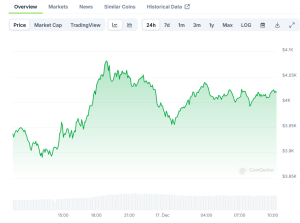Key Insights
- ROVI Network accounted for 99.9% of Boba BNB transactions, with 11.9 million transactions in Q3. ROVI Network is a “super app” that facilitates messaging, payments, and gaming.
- Transactions were flat, but daily average active addresses were down 48% QoQ. This difference emphasizes the dominance of platforms like ROVI, which route all traffic through forwarder contracts.
- DeFi TVL declined 38% QoQ, but new protocols like sports betting platform Dexsport and asset manager Teahouse are working to turn it around.
- The Erigon sequencer client is being used on devnet, preparing Boba Network to be the first optimistic rollup on OP Stack to use it in production.
- Hybrid Compute remains a core focus for Boba Network, with new developments being tested on the Anchorage testnet. Hybrid Compute enables developers to leverage offchain computational resources.
Primer on Boba Network
Boba Network is a Layer-2 multichain scaling solution with a focus on gaming. Boba operates on Ethereum and BNB, and it is maintained by Enya Labs. As an optimistic rollup (OR) based on Optimism’s codebase, Boba offers reduced gas fees, increased transaction throughput, L1 security guarantees, and EVM compatibility for smart contracts, such as NFTs and decentralized finance (DeFi).
This network also has unique features that set it apart from other ORs and Optimism forks, such as Hybrid Compute — the ability to connect to offchain computational resources, data, and APIs, a multichain focus, and fast exit bridging to L1.
Boba’s combination of features — specifically Hybrid Compute — enables decentralized applications (dapps) to run at a fraction of the cost of L1 dapps, leverage offchain computation via Web2 APIs, and provide the multichain solutions needed for blockchain gaming. Boba Network was previously active on Avalanche, Fantom, and Moonbeam, but those implementations have since been deprecated.
Key Metrics
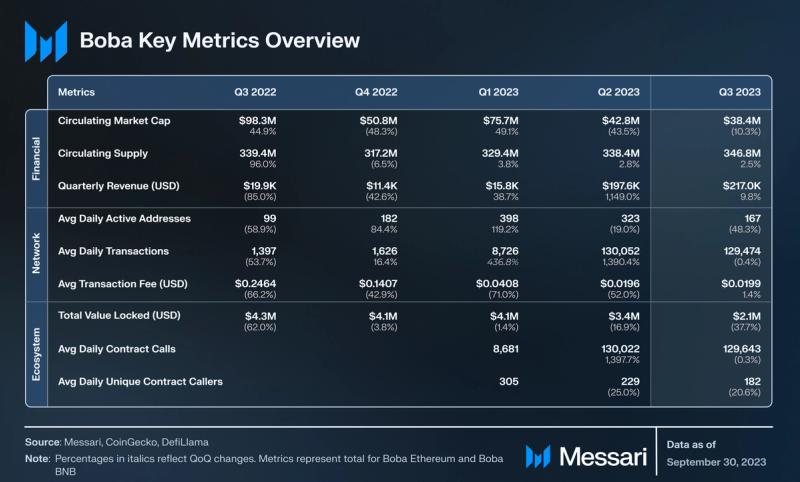
Financial Analysis

BOBA’s price declined 12.5% QoQ, setting a yearly low for the second consecutive quarter. BOBA is the native asset of Boba Network, and its primary use cases include settling gas fees, governance, and invoking Hybrid Compute within smart contracts. As of the end of Q3, BOBA’s market cap ranked 472 among all cryptocurrencies.
BOBA is an ERC-20 on Ethereum and BNB, as well as many on other EVM-compatible networks such as Avalanche. BOBA ended Q3 with a circulating supply of 346.8 million. BOBA primarily experiences inflationary pressure due to staking rewards and unlocks from the initial allocation of the 500 million total BOBA. Each quarter, 30 million BOBA is unlocked, which will continue until all tokens are unlocked in June 2025.
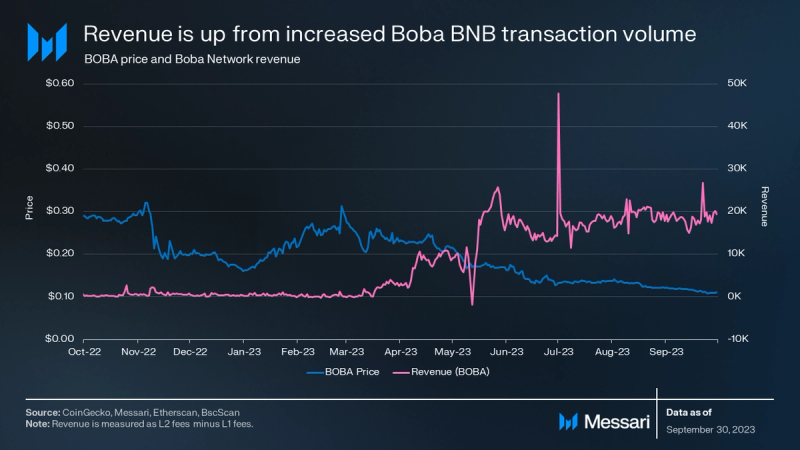
As a rollup, Boba Network implementations mainly focus on execution while outsourcing other core functions — such as settlement, consensus, and data availability — to their respective Layer-1s (L1s). As such, its revenue is measured as total L2 fees minus L1 sequencer fees. Revenue grew 25.5% QoQ denominated in BOBA and 9.8% QoQ denominated in USD, as BOBA’s price decrease offset the latter. This revenue increase came primarily from Boba BNB, as the high transaction volume brought in more L2 fees while the L1 sequencer fees stayed relatively stable. The low activity on Boba Ethereum caused negative revenue for that implementation on some days, as L2 fees did not cover sequencer fees.
Network Analysis
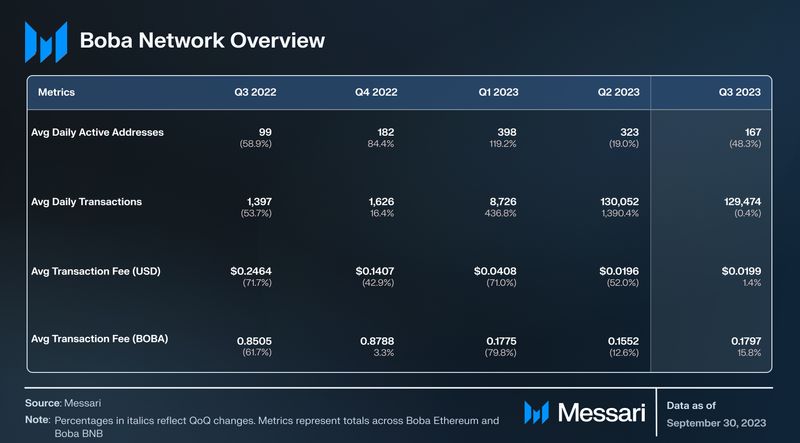
Average daily transactions were relatively unchanged in Q3, decreasing by 0.4% QoQ. This followed a breakout Q2, where transactions increased 1,390% QoQ from 8,700 to 130,000. As stated in the Q2 report, ROVI Network, a multi-purpose “super app,” was responsible for this drastic increase. Despite the relatively high number of transactions, daily active addresses remained much lower and even decreased 48.3% QoQ to 167. ROVI Network’s forwarder executes transactions on behalf of users that transact gaslessly, so it barely affects the unique contract callers metric.
Development has continued on the Light Bridge, an interoperability solution between Boba implementations.
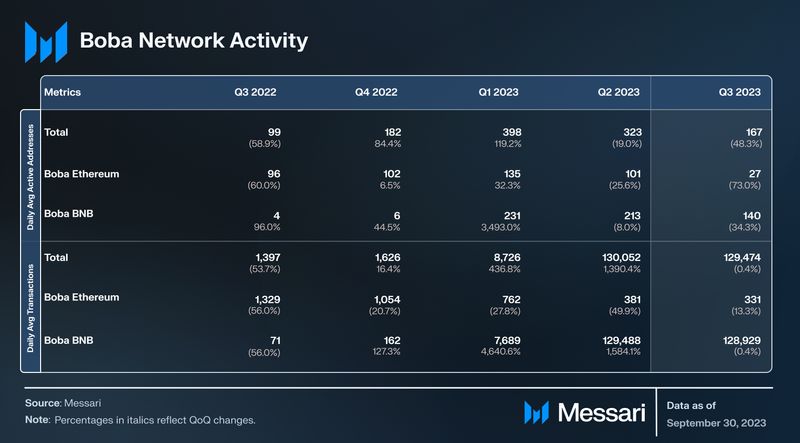
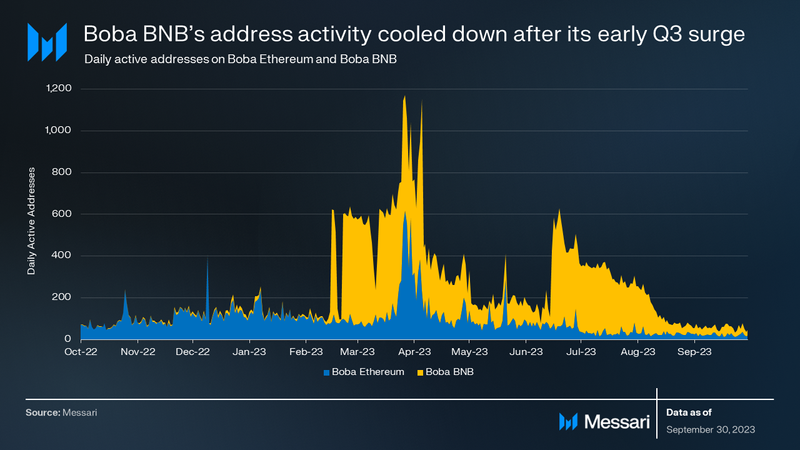
After launching in late 2022, Boba BNB became the leader in 2023 in nearly all activity metrics. In Q3, Boba BNB had 83.8% dominance of daily active addresses, despite average active addresses on Boba BNB declining 34.3% QoQ.

ROVI Network is overwhelmingly responsible for the high activity on Boba BNB when compared to Boba Ethereum. By the end of Q3, Boba BNB had processed 24 million cumulative transactions. For reference, Boba Ethereum has processed just over 1 million transactions since deployment in 2021. ROVI Network was responsible for 11.6 million of 11.9 million total transactions in Q3.
As part of the Boba Network V0.9 release, Boba AVAX was deprecated in Q3. This Avalanche implementation of Boba Network had negligible dominance in Boba Network’s overall activity metrics.
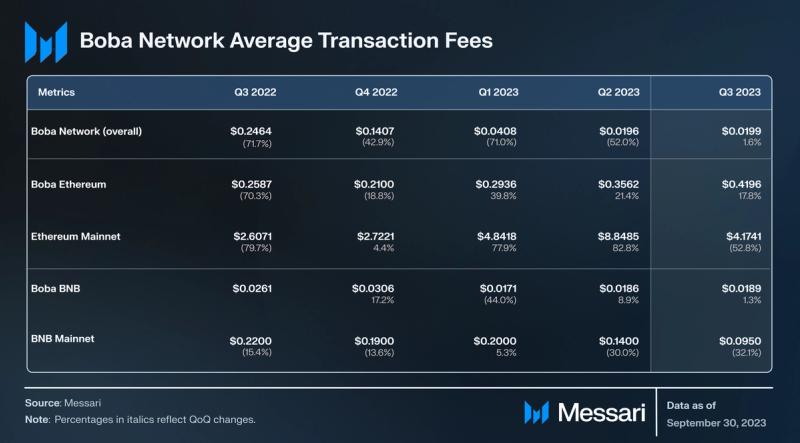
The average transaction fee increased for the first time in a year, up 1.6% QoQ to $0.0199. Boba BNB’s increased transaction dominance over the past year has brought down the overall average fee: Boba BNB fees (average of $0.0189 in Q3) were significantly cheaper than Boba Ethereum fees (average of $0.4196 in Q3).
Ecosystem Analysis
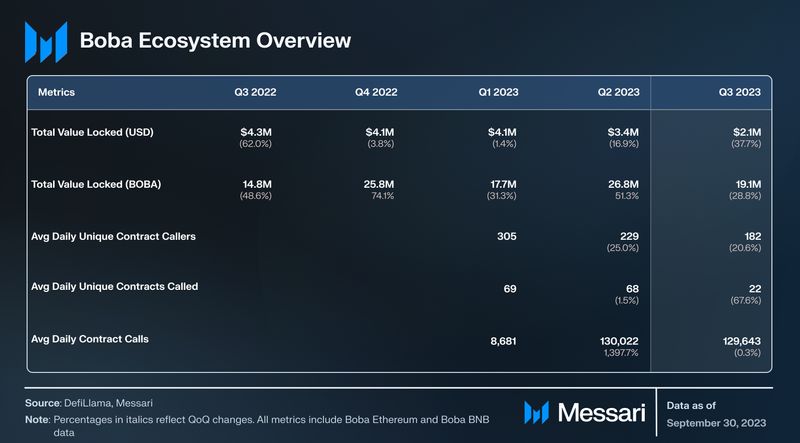
While average daily contract calls were flat, decreasing 0.3% in Q3, they did manage to retain the activity from Q2. In Q2, contract calls increased 1,397.7%. This metric is heavily attributed to “super app” ROVI Network. Unique contract callers and unique contracts called declined 41.5% and 67.6% QoQ, respectively. Due to the architecture of ROVI Network, increased user interaction only scales the total contract calls metric and not unique contracts or contract caller metrics. ROVI Network’s forwarder contract affects contract call metrics the same way it affects active address metrics, skewing them downwards.
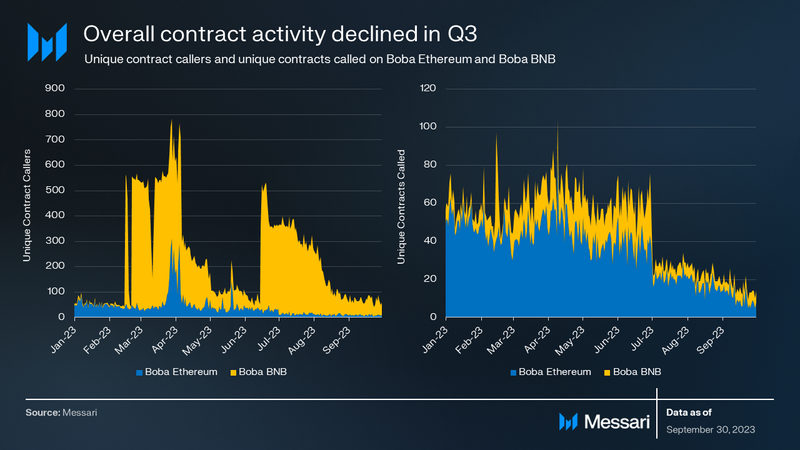
While Boba Ethereum further lost dominance in terms of daily active addresses, its established ecosystem dating back to 2021 continued to have many more dapps and contracts than Boba BNB. This relationship may explain the disproportionate 74% dominance of unique contracts called on Boba Ethereum in Q3, as users have more options to interact with.
The major increase in total contract calls starting in February 2022 came from the same addresses becoming more active, specifically ROVI Network’s forwarder contract and M91 contracts.
ROVI Network
ROVI Network is a multi-purpose infrastructure app that drives the majority of transaction activity on Boba BNB and the Boba Network as a whole. ROVI offers a social recovery wallet, an on/off ramp, and gasless transactions to create a familiar UX for both Web3 and Web2 users. Its token, which has 36,000 holders, is used for rewards and staking.
ROVI calls itself a “super app” because it packages many features into a single solution, like WeChat for the blockchain. ROVI integrates crypto through several pieces of infrastructure, including:
- Messaging, such as with existing platforms WhatsApp and Telegram, via Keyboard91.
- Financial services, such as payments, trading crypto, and earning yield on stables, via M91 Super App.
- Gaming, via Gaming91.
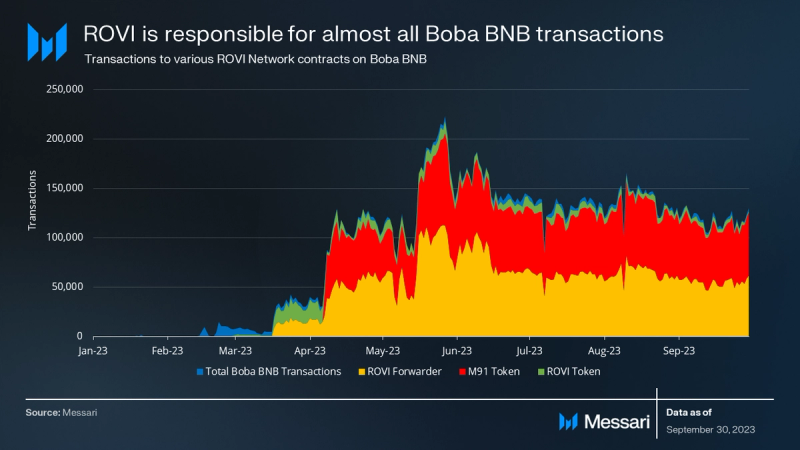
In Q3, three ROVI contracts accounted for 99.9% of all Boba BNB transactions:
- The ROVI Forwarder contract had 5.56 million transactions addressed to it
- The M91 token contract had 5.65 million transactions addressed to it
- The ROVI token contract had 0.5 million transactions addressed to it
Gaming
In Q3, two new game builders announced their intentions to launch on Boba Network. Convival, a gaming ecosystem, will launch on Boba BNB, and Open Games Builders announced that they will be building on Boba.
Existing games, such as battle-to-earn metaverse Homie Wars, PvP battle royale Katana Inu, MegaWorld, METAFORRA, Cosmic Universe, and EvoVerses continued to build on Boba.
Brinc, a venture capital and accelerator firm, partnered with Enya Labs in Q3. This partnership may bring more builders that hope to utilize Boba’s unique features, such as Hybrid Compute and a multichain focus.
DeFi
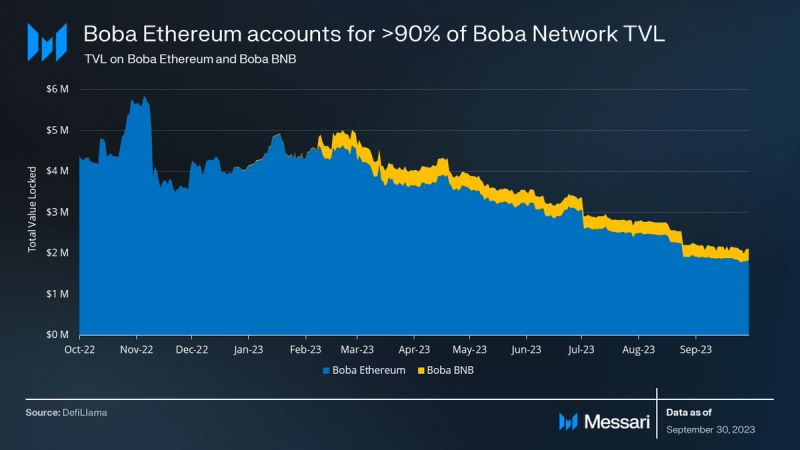
TVL (USD) declined for the sixth consecutive quarter, down 37.7% QoQ to $2.1 million. Boba Ethereum still accounted for the vast majority of Boba Network TVL, with over 90% dominance. Its dominance was largely due to Boba BNB being relatively new (deployed in H2 2022) and Boba Network fully pivoting to becoming a gaming chain. As a gaming chain, TVL is not as representative a metric for the overall state of the ecosystem as it is with many other chains.
A less-traditional DeFi platform called Dexsport launched on Boba Ethereum in Q3. Dexsport is a sports betting platform that launched a Q3 campaign to onboard users and give out rewards. Teahouse, a DeFi platform for cryptoasset management, also announced in Q3 that it will deploy on Boba.
SushiSwap, an AMM DEX, ended Q3 with:
- $850,000 and 40% dominance over total Boba Network TVL
- $754,000 and 41% dominance over Boba Ethereum TVL
- $96,000 and 34% dominance over Boba BNB TVL
OolongSwap (the first native DEX on Boba) and Symbiosis (a cross-chain AMM and bridge) are the second and third largest DeFi protocols, respectively, with 27% and 17% TVL dominance.
Growth and Development
Erigon Client and OP Stack
Enya Labs, a core contributor to Boba Network, has made a significant contribution to Erigon, an L2 Bedrock OP Stack-compatible client. Boba Network is on pace (in devnet) to be the first optimistic rollup on OP Stack to use Erigon as its sequencer client. Enya’s contribution to Erigon includes implementing support for eth_getProof upstream, a complex feature that had remained unaddressed since November 2020. This enhancement is crucial for any project aiming to leverage Erigon as an execution engine in the Optimism ecosystem. It’s particularly noteworthy as other projects have only been able to support running Bedrock as the replica. This distinction underscores the importance of Enya Labs’ work in augmenting the flexibility and diversity of the ecosystem.
Boba Network should benefit from compatible tooling from these adjacent ecosystems, as building with open-source technology is a positive-sum game. The greater ecosystem would even benefit from the adoption of L2s that use zero-knowledge proofs or offchain data as they push UX in multiple directions, such as developments in account abstraction from zkSync and Starknet that align with Boba’s own initiatives.
Hybrid Compute and Gaming
Boba Network aims to be the leading solution for gaming and metaverse applications via its Hybrid Compute feature. This feature intends to solve the problem of closed-off blockchain ecosystems. As it stands, blockchains cannot use any data or compute from outside of their ecosystem without an API or oracle. With Hybrid Compute, developers can:
- Create advanced algorithms that are typically too expensive to run onchain.
- Get millisecond response times.
- Generate random numbers and other resources that typically carry security concerns in decentralized computational environments.
- Access low-cost storage, image, and audio processing.
- Connect to external gaming services such as Unreal Engine.
- Instantly mint NFTs based on game activity.
- View offchain price feeds (e.g., CoinGecko) to create variable pricing/actions.
With Hybrid Compute, developers can leverage legacy Web2 systems and solutions to build higher-quality blockchain games. For example, Boba Avax adopted Avalanche games such as METAFORRA, Cosmic Universe, and EvoVerses, which can now leverage offchain compute and Web2 APIs. Boba has an upcoming Anchorage update that will include new developments on Hybrid Compute.
Closing Summary
ROVI Network has solidified itself as the main source of activity across both Boba Network implementations. For the second consecutive quarter, ROVI Network accounted for over 99% of all Boba BNB and combined Boba Network transactions. Boba AVAX was sunset, which allowed contributors to focus more attention on Boba Ethereum and Boba BNB.
Gaming remains a core focus of the community. Teams announced new games in Q3, such as Convival and Open Games Builders. Nw ecosystem growth strategies, such as partnering with accelerators like Brinc VC, may help Boba gain more traction in the gaming space. While Boba does not have as many builders as other gaming platforms/engines, it has Hybrid Compute, which offers offchain computation that other platforms/engines cannot match.


